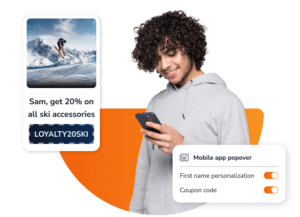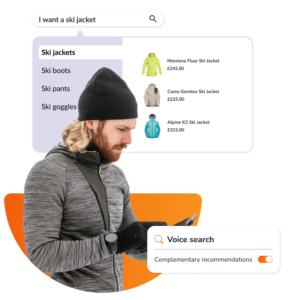Personalization has become a cornerstone for businesses striving to stand out in a crowded marketplace. The ability to tailor the online shopping experience to individual customers is not only a competitive advantage, but a necessity in today’s busy retail environment. In this blog post, we’ll delve into the world of eCommerce personalization, starting with a definition and exploration of what personalization means in the context of eCommerce. Then we will discuss the latest eCommerce personalization trends and how you can put them into practice.
What is personalization?
Personalization is the process of tailoring something to meet an individual’s needs or preferences. In the context of eCommerce, personalization takes on a distinct meaning. eCommerce marketers use data and technology to customize the online shopping experience for each visitor, to make the experience more relevant, engaging, and satisfying.
Personalization is all about treating each customer as a unique individual, understanding their preferences, and providing them with relevant content, product recommendations, and offers. Marketers are aiming to mirror the one-to-one shopping experience and personalized service customers might receive in a shop on the High Street.

5 reasons eCommerce personalization works
Why is personalization in eCommerce so crucial? The answer is in the power it holds to transform the way businesses engage with their customers. Here are a few key reasons why personalization is essential:
1. Enhanced customer experience
Personalization elevates the overall shopping experience by providing customers with content and product recommendations that resonate with their preferences. This makes the shopping journey more convenient and enjoyable.
2. Increased customer engagement.
When customers receive personalized content and recommendations, they are more likely to engage with the website, spend more time browsing, and ultimately make more purchases.
3. Improved conversion rates.
Personalized product recommendations can significantly boost conversion rates. When customers see products that align with their interests, they are more likely to purchase.
4. Higher customer retention.
Personalization helps build long-term relationships with customers. And when customers feel understood and valued, they are more likely to return for future purchases.
5. Competitive advantage.
In a highly competitive marketplace, businesses that effectively implement personalization have a distinct edge. Customers are more likely to choose a merchant who offers a personalized experience, as they know they will immediately find what they need.
eCommerce personalization trends
As technology and consumer expectations evolve, eCommerce personalization is constantly changing.
Nine Trends Shaping Personalized Online Shopping Experiences
1. AI and Machine Learning
Artificial Intelligence (AI) and Machine Learning are at the forefront of eCommerce personalization. These technologies enable businesses to analyze vast amounts of data and automatically customize the experience based on those insights. From product recommendations to chatbots providing personalized assistance, AI is revolutionizing the way customers interact with eCommerce platforms.

2. Hyper-personalization
Hyper-personalization takes it all to the next level by considering a customer’s past behavior and real-time context. It factors in location, time of day, and device used to tailor the experience to each shopper. For example, a customer might receive different product recommendations on a cold winter evening than on a hot summer afternoon.

3. Omnichannel personalization
Meeting individual preferences and behaviors across every channel enhances customer engagement and loyalty. When you provide consistent, personalized interactions, adapt to your customer’s needs across multiple touchpoints, such as the website, app, email and SMS, and produce a cohesive shopping journey, you will increase average order value and customer lifetime value. This individualized experience has been proven to be what the customer wants, time and time again.

4. Voice search and personalization
As voice-activated devices like smart speakers become more prevalent, voice search and personalization are gaining importance. eCommerce businesses are optimizing their platforms for voice search and ensuring that their product recommendations and search results align with the conversational queries customers make.

5. User-generated content (UGC)
UGC, such as reviews, ratings, and customer photos, are a valuable source of personalization. Customers trust the opinions of their peers, so displaying UGC alongside products can enhance the shopping experience and build trust.

6. Augmented reality (AR) and virtual reality (VR)
AR and VR technologies create immersive shopping experiences. Customers can virtually try on clothes, visualize how furniture fits in their homes, or experience products more interactively. These technologies provide a personalized and engaging shopping experience beyond traditional product listings.
7. Sustainability personalization
With growing awareness of environmental concerns, sustainability is a key element of personalization. Businesses are offering eco-friendly product recommendations and promoting sustainable shopping practices. This appeals to a segment of customers who prioritize sustainability in their purchasing decisions.
8. Personalization for B2B eCommerce
Personalization isn’t limited to B2C eCommerce. B2B eCommerce platforms are also adopting personalization strategies to cater to the unique needs of business buyers. Customized pricing, personalized product recommendations even for big product catalogs, and automated emails and SMS are some personalization elements that help streamline B2B purchasing.
9. Using zero- and first-party data
Take advantage of zero-party data (i.e., directly obtained from your customers) and first-party data (i.e., behavioral data collected from customer interactions) to personalize your eCommerce marketing communications. Use surveys, pop-overs, and preference centers to collect zero-party data. Browsing history, cart behavior, and purchase history will make up the bulk of your first-party data. Implement tailored recommendations, targeted messaging, and customized experiences based on this combined data for effective personalization.
Implementing eCommerce personalization
Selecting the right technology is the first big hurdle to a personalization strategy. Choose a best-of-breed platform that allows you to make changes to your campaigns without the usual barriers of external or internal IT teams. Make sure that the platform is easy-to-use, yet sophisticated — displaying personalized content automatically and constantly iterating with AI-driven optimization while allowing you to maintain full merchandising and brand control..
Data collection is the next important step in eCommerce personalization. Gather information on customer behavior, preferences, and interactions. This data serves as the foundation for future personalization, so make a strategic plan for gathering the data you will need.
However, here’s an important tip: Don’t collect data you won’t use. It will annoy your customers unnecessarily to provide data you don’t need. You can always collect more data as you progress in your relationship.
Now that you have a sizable database, it’s time to put your AI tools to work to divide your audience into logical segments. By dividing customers into distinct segments based on their behavior, demographics, and preferences, you can create tailored experiences for each group. This approach ensures that personalization is not one-size-fits-all but caters to the unique needs and desires of different customer segments.
Once the audience is segmented, create your personalized offers and content based on your business objects and the preferences of each customer segment. Personalization should extend across various customer touchpoints, including email marketing, product pages, mobile app, SMS and social media ads. Consider mobile at every touchpoint to ensure a seamless and personalized shopping experience across devices.
Test. Optimize. Test again. Too slow. Use AI-powered optimization for faster results than manual A/B testing and optimization. By constantly monitoring and deploying top-performing content, you increase ROI and ensure a highly relevant customer experience. This capability is particularly useful for time-bound events (i.e., Black Friday, Valentine’s Day, etc.). Also, make sure you are providing your customers with a feedback loop. Listening to customer feedback and adapting strategies accordingly is essential. The goal is to continuously refine and improve the personalized customer experience, ensuring it remains relevant and effective in the ever-evolving eCommerce landscape.
Conclusion
eCommerce personalization is not just a trend; It’s a fundamental strategy for success in the digital retail landscape. As technology continues to advance, the possibilities for personalization are limitless. By understanding the importance of personalization, staying updated on the latest trends, and implementing a well-thought-out personalization strategy, you can create meaningful and profitable relationships with your customers that last.






